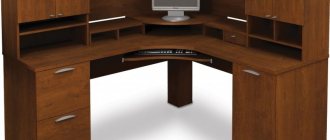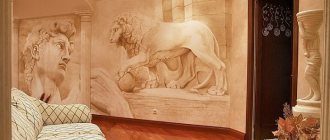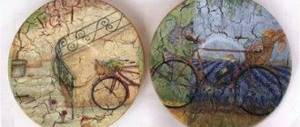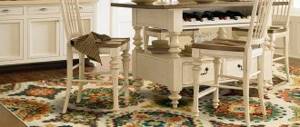Using a hand router when processing wood at home makes it possible to perform a variety of manipulations: forming edges, grooves and grooves. For each operation, a specific nozzle is selected. A detailed overview of the types of wood cutters for a hand router, their functions and designs will help you make the right choice.
Design features of cutters
When choosing the right cutters for your hand router, you need to know the following basic data:
- Shank size. It is indicated both in inches and in millimeters and determines the possibility of sharing equipment with a manual router. The diameter of the tool collet must be compatible with the diameter of the shank. Sometimes inconsistencies arise when considering different measures of length. So, ¼ or ½ inch in conversion gives 6.35 and 12.7 mm. The metric sizes of common types of collets are 6.8 and 12 mm. As you can see, there is no compatibility. Therefore, when choosing, pay special attention to this.
- Blade material and location. There are products made from carbide (HM) and high-speed steel (HSS). Carbide cutters are characterized by increased fragility. If you plan to process hard wood, it is recommended to use high-speed steel equipment. Considering the arrangement of the blades on the cutter, we can highlight some features. Vertical blades cut surfaces more aggressively. It is quite difficult to work with such nozzles, and the resulting surface turns out to be rough. It is advisable to use cutters with vertical plates in preliminary operations. Slanted blades cut wood cleaner and are used at the final stages of processing.
- Desired design of the cutting part. Wood cutters can be prefabricated, monolithic or replaceable. The prefabricated structure is a specific set of high-speed steel plates, which are attached to the cutter shank by soldering with copper alloys. Monolithic cutters are made entirely of tool steel. Mounted cutters (with replaceable cutting edges) are the most technologically advanced to use. They have a long service life, since the knives for them are made double-sided (when one side of the blade wears out, it is turned over and processing continues).
| Image | Name of cutter | Description |
| Monolithic | Made from solid metal | |
| Team | Is a steel blank with blades soldered on the sides | |
| Mounted | Consists of a removable plate fixed to a finger-shaped adapter |
Typical cutter design and blade options
The design of wood cutters for a manual router is typical: the shank and cutting part, dimensions and appearance, which depend on the tasks assigned. Let us consider their structure in detail.
Shank - attached to the router chuck
It can have a different design - cylindrical, conical, sometimes a flat is machined on it to prevent slipping in the chuck.
The tail is cylindrical
The main task of the shank is to ensure reliable fastening to the required depth of penetration of the equipment into the material.
It is possible to install a guide bearing on the shank. It serves as a kind of stop for bending around the template or moving along the guide edge of the workpiece.
The advantages of this design are that it wears out less and the bearing is easy to replace. The bearing attachment does not require installation of a copy ring on a hand router, which simplifies work with the template.
Cutting part
Determines the shape of the milled surface. It can be made both in the form of molded grooves on the main body of the tool, and carbide brazing on a softer base.
The cutting part is either monolithic or consists of replaceable dial disks mounted on an axis. For example, like on a microtenon cutter.
Microtenon is used in tenon joints, consists of stacked disks
The stacked version is more practical because it allows you to create different configurations on the same shank. However, due to the complexity of manufacturing, they have a higher cost. Replaceable disks have a second name - attachment cutter.
Replaceable disk
According to the type of material, cutters are divided into two groups
- High speed, HSS classification. They mill soft wood very efficiently and at high speed. On hard rocks they overheat and quickly become dull. Advantages - low cost.
- Carbide, HM classification. Designed mainly for processing hard wood. They wear out more slowly, but are more fragile and on soft wood it is difficult to achieve a perfectly flat surface. The processing of the workpiece takes longer. The cost of these attachments is higher than high-speed ones.
The working surface (sharpened edges or cutting teeth) can have different shapes. Straight ones are easier to maintain, but get dull faster. When passing through, dissimilar wood can cause chips and gouges.
note
Helical-shaped edges provide an ideal milled surface, but sharpening them requires special equipment, so as they become dull, as a rule, a new attachment is purchased.
Sharpening angles for different attachments
Much depends on the angle at which the working edge is sharpened. Usually it does not exceed 90 degrees and is selected according to the type of material with which the nozzle will work. After the rear platform of the cutting edge comes a complex-shaped structure called a chipbreaker.
Without proper removal of chips from the working area, high-speed rotation of the equipment will become impossible.
Set cutters often have double-sided sharpening. This allows you to use one disk twice as long. When one side becomes blunt, the element simply flips 180 degrees.
But this design does not allow the use of a system of complex trailing edge angles and grooves for chip removal. As a result, the efficiency and quality of work of the nozzle decreases.
Types of wood cutters
There are different types of cutters that perform specific processing functions. Let's look at the most common options.
Grooving cutters
These devices are designed to select a groove of the required width and depth. Their use is widespread when creating groove-tenon joints. When working, you need focus and practical skills. Without a template, it is almost impossible to get an even rectangular groove.
| Grooved straight lines are a cylindrical device, after use of which a rectangular groove remains in the workpiece. Mainly used with plunge milling machines. | |||||
| Grooved fillets have a rounded cutting head. Thanks to this, the groove in the section is U-shaped. Depending on the depth of the cut, the walls are rounded immediately from the surface of the workpiece or first go from it at a right angle. | |||||
| Slot cutters with V-shaped end. When using them, you can get a shallow groove with side walls inclined relative to each other at an angle of 90°. If the work involves making grooves with different angles of inclination of the walls, then you need to have the appropriate set of tools. | |||||
| Grooved structural (T-shaped and dovetail). In cross-section, the resulting grooves form an inverted letter “T”, the base of which extends to the surface or a regular trapezoid, the larger side of which faces the center of the workpiece. As a result of processing, one of the most reliable connections is obtained when the workpieces are pushed into one another. A cutter with a reverse cone for producing dovetail grooves is indispensable in the manufacture of wooden furniture, when one fragment is removed and the second is fixed to the base using the specified groove. | |||||
| Groove shaped ones are used to produce figured threads and edge processing. In cross-section, the grooves resemble curly braces. You can machine both the grooves in the center of the workpiece and its edges. If a complex pattern is being made, it is recommended to first go along its contour with a straight groove cutter - this will simplify subsequent alignment and reduce the load on the milling machine when using a shaped cutter. | |||||
Edge cutters
This equipment is most often made with a bearing, which allows you to process the edges and ends of wood not only by adjusting the support table, but also according to a template. The depth of penetration of such a cutter into the workpiece can be limited by installing a thrust bearing.
| Edge straight lines are designed to obtain a plane of the end of the workpiece, perpendicular to the upper part of the workpiece (face). If there is a bearing on the cutter, rounded edges can be processed. The bearing itself can be configured flush to the cutting blades or have a different (up or down) diameter. | ||
| Edge moulders are designed to produce straight, arched or wavy figured edges. Widely used for making patterns of complex shapes. When choosing a double cutter, you need to pay attention to the possibility of adjusting the distance between the cutting blades. A set for a hand router usually includes several standard sizes of such a tool, which allows you to create edges with different radii of curvature. Installing a support bearing allows you to get a straight edge when inserting the tool deeper into the wood. | ||
| Edge cones , depending on the angle of inclination of the edge of the cutter, are used to prepare workpieces before joining, obtaining a decorative chamfer, or for processing furniture parts, which will then be joined into products of a round (polygonal) shape. | ||
| Edge fillets are used to obtain a rounded groove on the edge of the workpiece. To avoid distortion during processing, cutters are manufactured with two bearings. Such a tool is quite versatile, since the size of the groove arc depends on the depth of immersion of the blade into the material. Thanks to it, you can make decorative furniture slats. | ||
| Curly edging (multi-profile) is a fairly massive tool for a router. Such cutters simultaneously work with a large area of the workpiece and their use requires the use of machines with a power of at least 1600 watts. For work, the entire blade profile is used at once or in various combinations, which allows you to obtain an edge of a standard or specified shape. | ||
| Edge semi-rods are designed to produce a semicircular protrusion on the edge. Also, with the help of such cutters, profiles with chamfers and edges of complex shapes, and hinged joints are produced (when processing a workpiece in conjunction with a fillet or molding cutter). | ||
Combined cutters
Used for joining and joining wooden pieces. Combined cutters combine groove and tenon cutters.
| Combined universal ones make it possible to obtain compatible planes with a tongue and groove located at an angle to each other. The same cutter is used for jointed workpieces, which significantly reduces processing time. | ||
| Groove-and-tenon . In this case, a set of two separate cutters is used: to create a groove in one workpiece and a tenon in the other. The samples used for the manufacture of linings make it possible to obtain a shaped connection with a larger contact area between the workpieces. | ||
| Combined frames allow you to arrange the cutting blades on the axis in the desired order. Consists of a base, cutting blades, thrust bearings (one or more), a lock washer and a lock nut. When changing the router bit's configuration, the base is not removed from the router collet to maintain its original setting. | ||
Figurine cutters
The main purpose of this equipment is to create decorative panels. For ease of operation, figurine cutters are equipped with a bearing.
| Figurine horizontal ones are used for partial processing of panels. The shape of the blades involves sampling starting from the thrust bearing. This does not allow you to immediately get a tenon for inserting the panel into the frame. To form it, additional edge processing is required. | ||
| Curly horizontal double-sided ones allow you to process the workpiece in one pass, simultaneously forming a figured part of the panel and a tenon for a groove cut in the frame. | ||
| Figurine vertical ones are used for the manufacture of skirting boards of various shapes. After processing, a decorative frame and tenon joint are formed on the workpiece. | ||
Functional sets of cutters and more
Quite often, manufacturers create sets of cutters designed to perform the same type of work, with a completed cycle of processing wooden products or producing the same type of joints.
This set of 2 cutters not only forms the inner edge of the frame product, but also makes the groove part of the corner joint in this frame. It is easy to understand that it can also be used to join boards into panels.
This set is used for making thin wooden window frames and other similar works.
But each of its cutters, of course, can act as an independent tool for performing a number of other types of wood processing.
The composite cutter shown in the following photo, depending on the sequence of assembly of its constituent elements, is used to form both edges of the wooden lining.
And by using a metal sleeve of the appropriate size instead of one of its components, this cutter can become either a moulder or a disk edge cutter.
Of course, as with other hand-held power tools, you can greatly expand the capabilities of a hand router by building a table for it.
By attaching movable stops to it, you will turn the hand tool into something like a milling machine. And with its help and a set of cutters, like the ones mentioned above, you can do very interesting things:
We recommend other articles on the topic
Kreutzmeisel, tool for chopping metal
Gun for polyurethane foam - the right choice, disassembly and repair
Miter box - from simple to precision, how to use the tool correctly
Drill - characteristics, application, DIY production
Quality criteria
When choosing a set of woodworking attachments, you should pay attention to the following:
- Soldering of typesetting cutters must be done in such a way that the tool does not lose its longitudinal stability during long-term processing. This is especially true if the workpiece is made from hornbeam, pear, oak and other hardwoods.
- When soldering tools, grades PSr40 or PSr37.5, with a high content of silver and copper, should be used as solders. Other brands of solder usually include nickel, which impairs the strength of the connection between the plates and the shank.
- The easiest way to check the thermal strength of a set cutter is by the thermal deformation of the tool while heating each tooth to a temperature of 200 - 250ºC. The tool after such processing should not allow its longitudinal axis to run out by more than 0.05 mm.
- The stacking cutter should not be made by welding the shank to the working cutting part. The use of such equipment is unacceptable.
An important parameter is the hardness of the materials from which the cutters are made. More often, this applies to monolithic samples. The test can also be performed at home. To do this, it is recommended to use a calibrated file, after contact with which there should be no visible marks on the working surface of the cutter. This roughly corresponds to a hardness of 58 - 62 HRC.
The durability of a tool is determined by the intensity of its use. High-quality stacking cutters with working plates made of high-speed steel have the best durability, while monolithic cutters made of tool steel have the least durability.
Purchasing the right woodworking machine will not solve all problems. To carry out full processing of products, you will need to select high-quality equipment. The types of wood cutters discussed in the review will help you decide and complete your hand router. After all, in performing each specific operation, a certain configuration of devices is involved.
Slot cutters
They are also called end saws, can withstand radial loads, and are designed for milling slots of various sizes and configurations.
They are divided into separate types:
- Straight – designed for making rectangular grooves.
- Triangular - they are used to mill V-shaped grooves.
- Shaped - give the groove a figured shape; you can imitate a panel pattern on the surface.
- Dovetail, a type of structural cutter, is used to make tenon joints with the same name. Milling is possible only with the use of a special template.
- Structural - choose grooves in a “T” shaped configuration. During operation, it is necessary to ensure that chips are removed from the groove.
- Fillet - cut semicircular grooves, used in surface decoration.
Examples of slot cutter grooves
For very deep grooves
The photo shows an example of a groove cutter for very deep grooves; it is used for inserting locks and making grooves for hinges in doors and openings. The equipment is available in diameters of 16, 20, 24 mm, the length of the working part is 50 mm. Carbide knives are secured with screws. They can be purchased separately as a set of main ones, trimming ones and, if necessary, replaced independently. The cutters are designed for the Festool OF 2200 router and are used together with the KR-D 30/21.5 / OF 2200 copying ring. Thanks to the non-sharpening inserts, they have a constant diameter, which is very important when working with templates. In addition to the separately sold attachments, there is a set HW KN D20/D24 WP/K, consisting of cutters D 20x50 and D 24x50, a copy ring, two replacement knives, four screws, two scoring knives, Topx T15 wrenches and a socket wrench 22. The set is supplied in the Festool Systainer.
Popular: Make a lift for a router yourself, or buy a ready-made one? Let's answer this question.
Straight slot cutters
Straight nozzle
They have parallel cutting edges that, when rotated, outline a cylindrical surface.
They process straight grooves, and in combination with a copy sleeve, thin cutters of this type are suitable for cutting curved flat workpieces according to a template. Their dimension is determined by the diameter and length of the cutting part.
Fillet V-groove cutters
Triangular cutter
They leave a straight groove in the shape of a triangle, which is why they are also called triangular. A similar profile is applicable as an element of decorative carving or as a kind of guide for moving, for example, a drawer, which is sometimes found in old furniture.
Structural groove cutters
Designed for making joints such as dovetails or inverted T-slots.
Dovetail
The same cutter can be used to produce simple box joints for lightly loaded boxes, such as boxes. Their dimension is determined by the maximum diameter, angle of inclination, and height of the working part.
Structural T-shaped
Let's start with a review of combined frame cutters.
Milling cutters for micro-tenon splicing, or “mouse tooth”
For splicing workpieces
Typically used for splicing long workpieces lengthwise.
But such cutters can be used in another way: attaching plates to the end to obtain decorative effects or make wide panels.
Shaped slot cutters
As the name suggests, they are designed for grooves with shaped side surfaces. Of course, when using a rip fence or a copying sleeve, they can be used to process the edges of workpieces.
The choice of such nozzles is quite large, and the dimension is defined as the largest diameter, the radii of the side recesses or convexities and the height of the cutting part.
Two detailed video stories, with the selection of tools for your work. Purpose of cutters, types, methods of application - video Choosing wood equipment for a router - video Some of them are also suitable for making large-area recesses, such as compartments in boxes, recesses in non-round saucers, wooden trays and other similar work.











